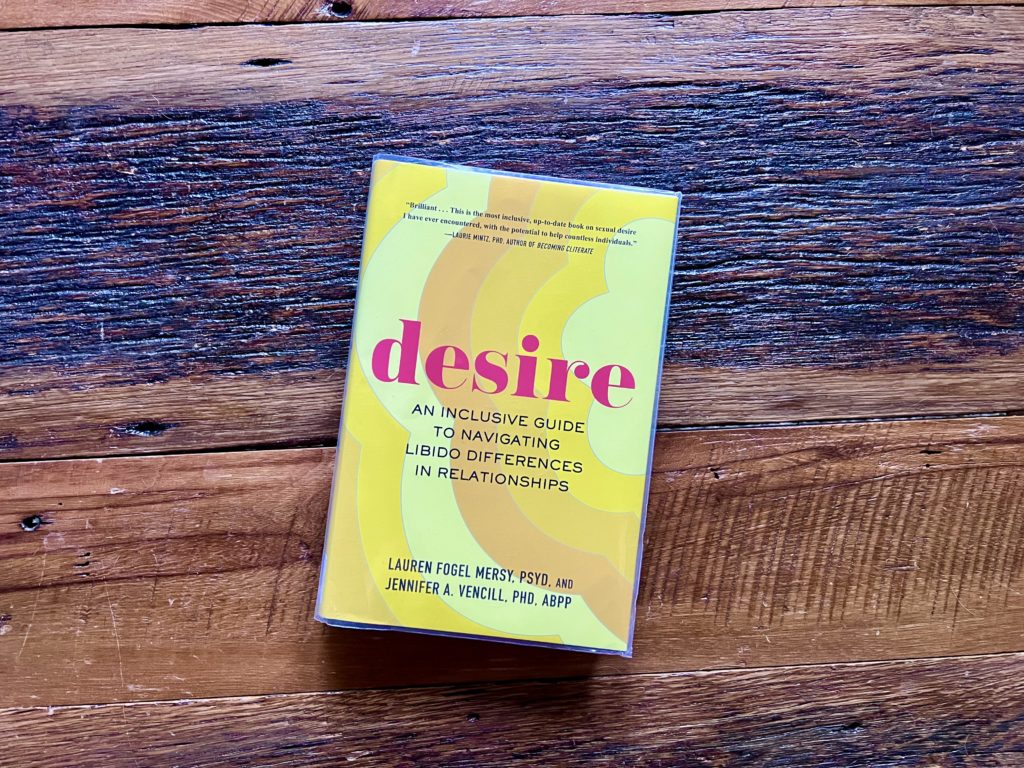While the impact of living with chronic illness, chronic fatigue, or chronic pain on a person’s sex life may seem pretty obvious, I’ve always been surprised and frustrated by how few stories and resources there are out there to help patients deal with this sensitive topic. It’s the reason that I started writing about my own sex life on the internet years ago – I want people struggling with these issues to know that they are not alone.
Of course, that’s not to say that my husband and I have sex and intimacy all figured out. With our own jobs, the care of three kids, the fluctuations of my RA, other life stressors, and all the emotions that go along with all of that, this is an area that’s always a work in progress for us. So, for my own sake as well as for what my community might be able to learn, I was excited to pick up a copy of Desire: An Inclusive Guide to Navigating Libido Differences in Relationships, by Lauren Fogel Mersy, PSYD and Jennifer A. Vencill, PHD, ABPP.
I want to start my review by pointing out that this is not a book that focuses specifically on libido differences through the lens of chronic illness. While cancer is mentioned as a specific concern, there is no more than a partial reference to arthritis, chronic pain or fatigue, or other mobility challenges as potential causes of this type of relationship difficulty. However, since differences in libido are very common among partners where one is living with a chronic illness (understandably!) I do think that this book can be a useful resource.
The book focuses on partnerships where there is a discrepancy in desire – that is, there is a “high libido” partner who tends to want sex more often, and a “low libido” partner who tends to want sex less often. As a mom of 3 living with RA, I’ll bet it isn’t difficult to guess which of these roles I fall into! This particular issue has been a struggle in our relationship for a very long time, so I have done a fair amount of reading on the subject. Refreshingly, this is the first resource I have come across that did not push the often repeated “fake it until you make it” or “just start, you’ll get into it as you go” style advice I have found elsewhere.
Instead, Desire boldly frames the issue not as a “problem” the low libido partner has to “fix” or “work on,” but as a relationship issue that needs to be addressed as a team. The authors point out that there is no right or wrong amount of desire/libido for any person to have – and they explain that the “problem” only arises from mismanaging the difference in the amount of sex and intimacy that is desired by each partner. They repeat multiple times: “desire differences in relationships are actually the norm rather than the exception.”
After explaining and normalizing something that can sometimes feel like a personal flaw, the authors go on to explain the different types of sexual desire: spontaneous desire and responsive sexual desire. Using a metaphor to see the difference, spontaneous desire is like a microwave, “it’s quick to get turned on.” On the other hand, responsive sexual desire is more like an oven, “it takes more time to warm up and preheat.” Simply understanding which type of desire each partner usually has can go a long way towards understanding the intimacy issue a relationship may be facing.
The authors also ask readers to reevaluate the traditional, heteronormative view of sex, what they refer to as the “Sexual Staircase,” where intimate touching between partners ascends from foreplay to penetrative sex, with the end goal of orgasm. Instead, readers are encouraged to adopt “the Wheel Model,” where sexual activities are not organized hierarchically, and therefore all have equal value. Using the Wheel Model, partners with libido differences have a better chance of mutual satisfaction with their sexual experiences.
The book goes on to offer practical suggestions and exercises that both partners in the relationship can work on to take responsibility for finding a solution together. In addition to promoting open and honest communication between partners, an important foundation of the book is this: “everyone is responsible for their own pleasure.” This means that it is not the responsibility of the lower libido partner to provide sex for the higher libido partner.
“Differences in desire are not problems that are specific to any one partner,” the authors write. “They are relationship issues and need to be approached as such. We find that it’s tremendously helpful for partners to address sexual desire discrepancies together, reinforcing that they are a team and that there is a role for all partners involved.”
With a robust list of additional resources at the end, this book offers a truly inclusive approach to navigating libido differences between partners.
📚📚Want to purchase your own copy of “Desire – An Inclusive Guide to Navigating Libido Differences in Relationships”? 📚📚Please use our Amazon Affiliates link by clicking here! Mamas Facing Forward may receive commission at no extra cost to you. Those funds will go towards providing more resources for moms and moms-to-be living with chronic illness, so thanks for using our links!

